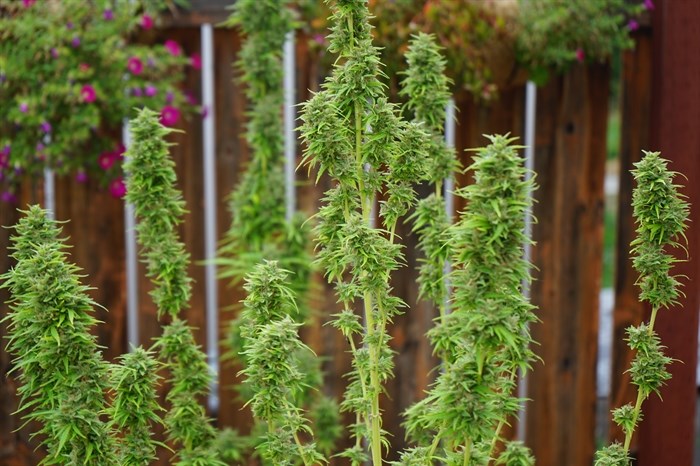The best time to harvest outdoor cannabis in the Okanagan depends on the strain
With the end of the third legal growing season in Canada, it’s high time for cannabis farmers of the Okanagan to harvest their crops.
The optimum time for local growers to plant marijuana outdoors depends on which part of the valley they live in — like any crop, the growing season begins down south in Osoyoos and works its way north. But harvest time is different – as the best time to strip the buds off the plant will vary by strain.
“A farmer in Osoyoos could grow one strain that’s not ready until mid-October, whereas someone in Vernon could grow another that’s all ready to harvest by mid-September,” said Jaimie Miller-Haywood, author of the blog Growing Home Okanagan in Vernon.
“But down south you’re going to end up with fatter buds because with an earlier and longer growing season, you’re absorbing more sun rays throughout the summer,” she said.
Early in the summer of 2021, extreme heat waves took a toll on many other crops over the summer, but those temperatures only helped pot plants get higher.
Many temperature records were broken in 2021, including 49.6 Celsius in Lytton, B.C. – the hottest ever recorded in Canada. Those intense temperatures were detrimental to crops like cherries, raspberries and blueberries, but the roots of cannabis trace back to regions in India and Pakistan, where the climate is historically much warmer than southern B.C.
“Even 100 years ago (India and Pakistan) were hitting high temperatures compared to what we experienced up here,” Miller-Haywood said.
“As long as the roots are well maintained, and water is frequent, they’ll do well. I’d be really surprised if you could overwater on those 40 degree days.”
READ MORE: Modern gardener: Cannabis cultivation alluring to Okanagan green thumbs
Also, keeping the soil protected from direct sunlight with a cover crop or mulch or straw “makes a world of difference.”
Cannabis wouldn’t naturally grow as far north from the equator as the Okanagan because temperatures drop lower than it can survive. B.C. growers try and cultivate strains to become more adaptive to the province’s climate, but the plant spent most of its evolution in regions where sunlight is more abundant.
“We’re not going to get the gigantic 15-foot monster weed trees that you see down in Humboldt County in California, they’re so much closer to the equator and have a way longer growing season…. Our quantities may be smaller than our southern counterparts, but we really do have a beautiful growing season here.”
Miller-Haywood said one of the biggest challenges for pot growers in the Okanagan is the end of the season – this time of year – when temperatures drop and humidity rises, but the buds aren’t always ripe for the picking.
The plants can survive mild amounts of frost but are very susceptible to the cold, and more precipitation leads to a greater chance of mould. Both issues apply more to those growing sativa plants, as those strains tend to take longer to mature than indica.
For locals who want to grow sativa anyway, Miller-Haywood recommends they find a hybrid strain that begins to bud sooner.
Despite those end-of-season challenges, it’s still pretty easy to grow pot anywhere in the Okanagan thanks to the hot and dry summers. Miller-Haywood said the valley’s low precipitation and high elevation offer even better growing conditions than in the Nelson area, but despite the advantages, the Okanagan’s reputation for good bud lags behind the West Kootenays.
Within such a beneficial climate, Miller-Haywood feels like growers in the Okanagan are in a strong position to improve that reputation.
Across Canada however, she feels like British Columbia is not capitalizing on the market as it should be. She believes the province’s cannabis industry entered the era of legalization with a big lead, as it begun developing long before prohibition was ended, but said smaller growers are prevented from operating craft cannabis business because of over-regulation.
“B.C. should have been the first province to really grab it by the reigns and develop it into something people travel to from around the world, just like our wineries.”
READ MORE: Vernon is the cannabis capital of B.C.
To contact a reporter for this story, email Dan Walton or call 250-488-3065 or email the editor. You can also submit photos, videos or news tips to the newsroom and be entered to win a monthly prize draw.
We welcome your comments and opinions on our stories but play nice. We won't censor or delete comments unless they contain off-topic statements or links, unnecessary vulgarity, false facts, spam or obviously fake profiles. If you have any concerns about what you see in comments, email the editor in the link above.




